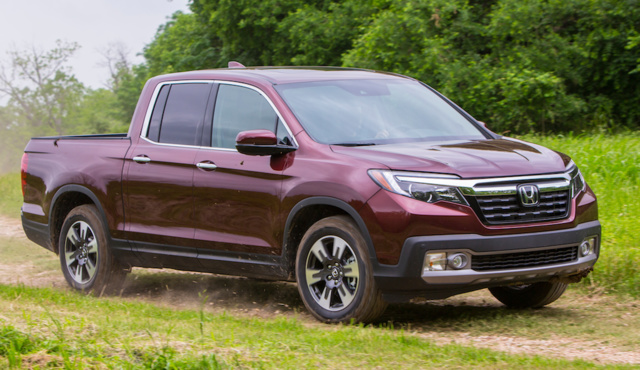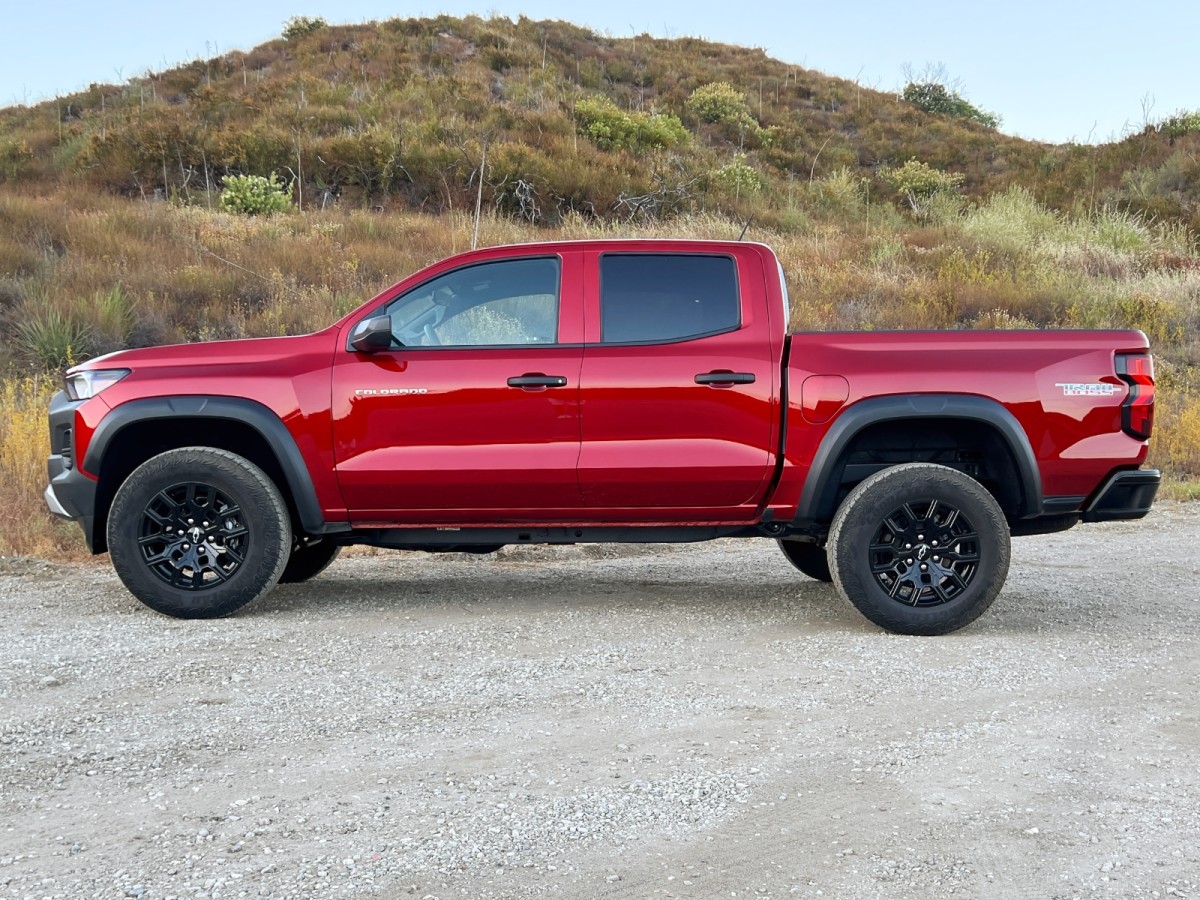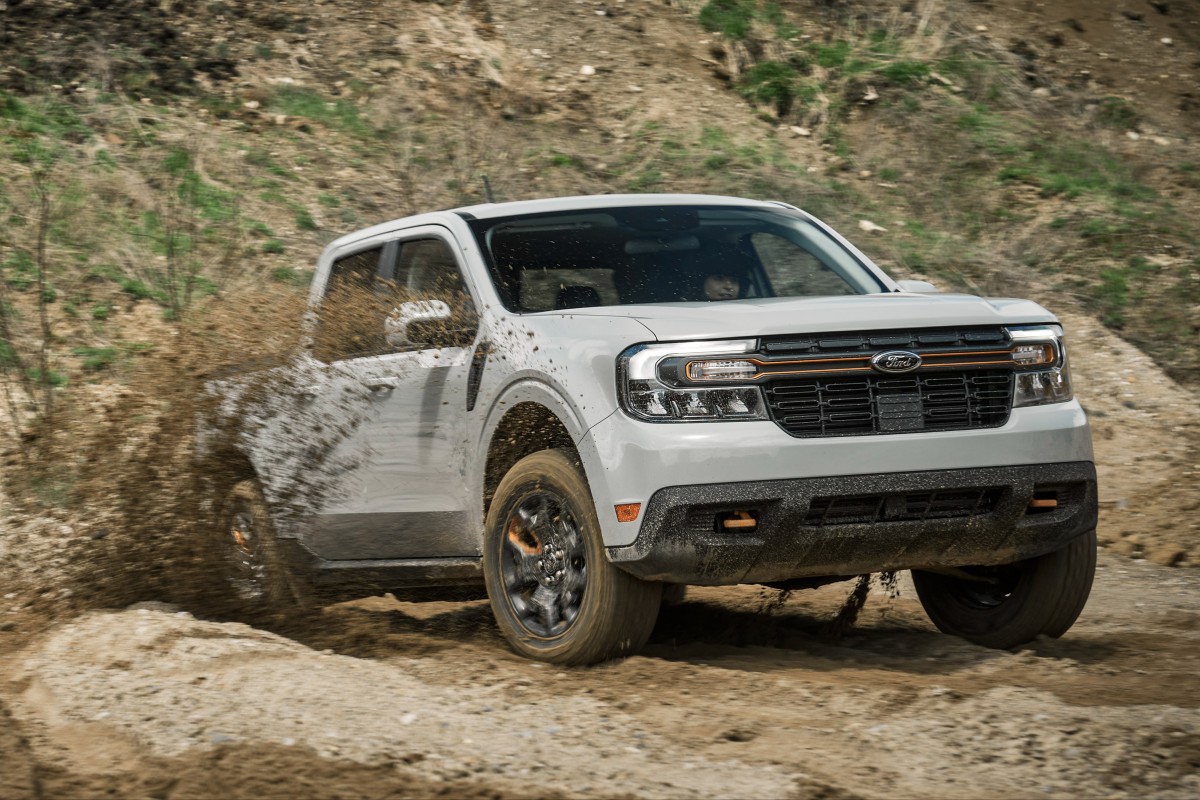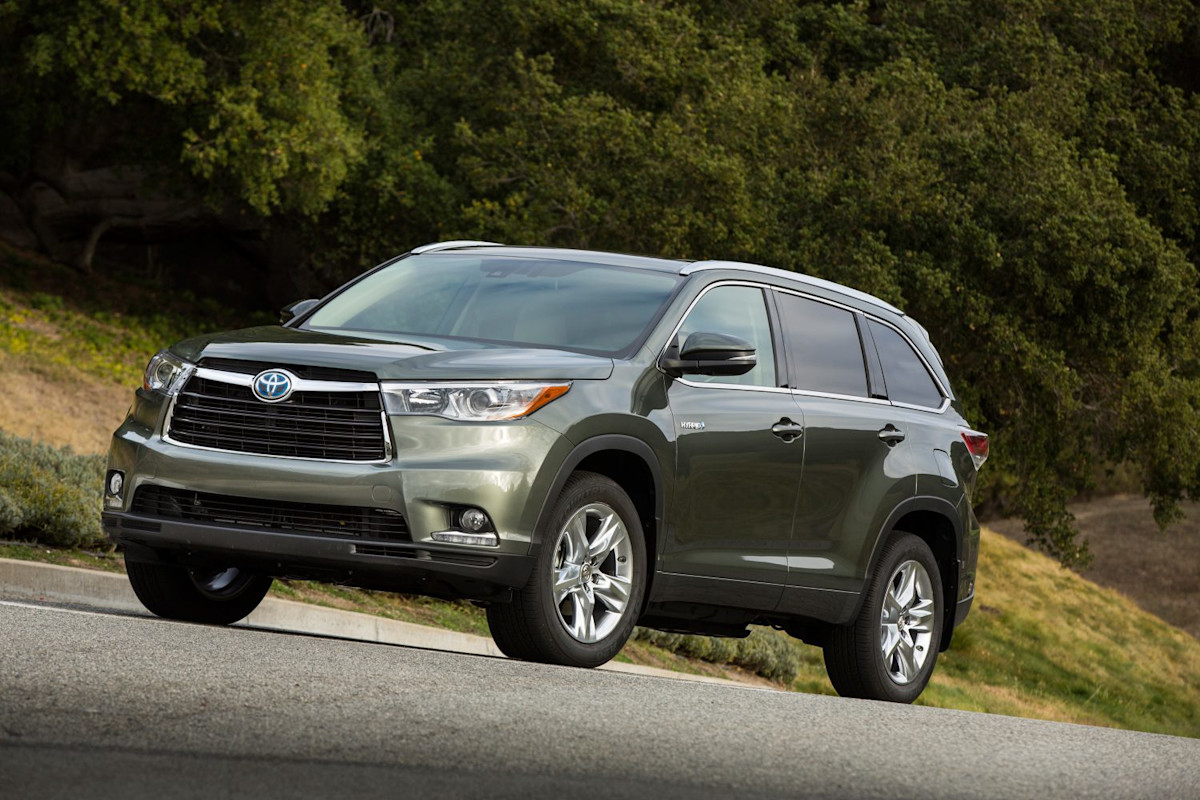Pickup trucks are a symbol of Americana. Our love of these faithful rigs has secured them as some of the best-selling vehicles ever, especially in full-size form. Back in 2023, the half-ton Ford F-150, Chevrolet Silverado 1500, and Ram 1500 swept the top three positions on the national sales charts, reaching two millions units sold.
However, "best-selling" doesn't necessarily mean "most-affordable:" The average new pickup truck price reached $60,000 on dealership lots last year. Thankfully, because there are so many new models sold, there are plenty of used truck options on the market. Even better, the hotly competitive nature of big-selling pickups means that even options from a decade ago offer a lot of the same utility, creature comforts, and interior dimensions as today’s trucks. That's equally true for a smaller, two-seat work truck or a family-friendly crew-cab model.
To help guide you to the right truck without breaking the bank, we’ve set a price cap of $25,000. In general, if you’re looking for a pickup at this price, your best bet is to set your sights on one of the lower trim levels, which will net you a simpler truck but likely a much newer and cleaner one. Top trims and Heavy Duty models tend to be a bit pricier, but there are choices available in this price range with more miles. Buyers will pleased to learn that niceties like alloy wheels, heated and power-adjustable seats, and accessibility features such as Bluetooth, satellite radio, Apple CarPlay, and Android Auto can be found here, too.
Finally, the modern pickup trucks on this list all have automatic transmissions, too, and most are offered with either rear-wheel drive (RWD) or four-wheel drive (4WD). Let’s run through some solid used truck options worth taking for a test drive.
The Best Trucks Under $25,000 in 2025
- 2012 to 2022 Chevrolet Colorado / GMC Canyon
- 2011 to 2020 Chevrolet Silverado 1500 / GMC Sierra 1500
- 2015 to 2020 Ford F-150
- 2011 to 2016 Ford F-250 Super Duty
- 2022 to 2023 Ford Maverick
- 2019 to 2021 Ford Ranger
- 2006 to 2020 Honda Ridgeline
- 2007 to 2021 Nissan Frontier
- 2009 to 2018 Ram 1500 & 2019 to 2021 Ram 1500 Classic
- 2012 to 2018 Toyota Tacoma
2012 to 2022 Chevrolet Colorado / GMC Canyon
A brand new Chevrolet Colorado and GMC Canyon debuted for the 2023 model year, which means that these second-generation models are now old hat. But even though they may be yesterday’s news, these trucks offer a few things that the brand-new Colorado and Canyon do not, and they’re attractively priced. You won’t find the specialized off-road Colorado ZR2 models at this price, and models from the later years will be more expensive, but careful shopping should be able to yield good, low-mileage examples of the rest of the line.
These versions of the Colorado and Canyon are largely credited with reviving the nearly moribund market for midsize trucks in the mid-2010s, and both debuted in 2014 as 2015 models. They’re refined drivers as full-frame pickups go, and they have more interior space than the Toyota Tacoma or Ford Ranger, even if their back seats are small compared with a big Silverado or Sierra Crew Cab. They come in extended or Crew Cab form and, in the former, with long or short beds.
From the start there were two drivetrains: a 200-horsepower 2.5-liter four-cylinder and a 304-hp 3.6-liter V6. A 181-hp 2.8-liter turbodiesel four-cylinder arrived in 2017. Don’t let that 181 hp rating fool you, though, because with 369 pound-feet of torque, the diesel was strong enough to boast a 7,700-pound tow rating-the highest capacity of any midsize truck at the time. The Colorado and Canyon are tough, simple, and comfy, and even fairly capable off-road with 4WD. The only versions worth avoiding are the very base models, as the gas-powered four-cylinder isn’t very powerful. If you need anything more than a work truck, though, both of these models are very good choices.
2014 to 2020 Chevrolet Silverado 1500 / GMC Sierra 1500
These years cover the third-generation (2014 to 2018) and fourth-generation (2019 to present) Chevrolet Silverado and its fancier cousin, the GMC Sierra. Although some power, payload, tow ratings, and interior design elements differ, under the skin, these trucks are two peas in a pod. They use the same engines, same chassis, and same basic systems. GMCs tend to be a little higher-end, and after 2019, they looked a little more handsome, but all make good full-size truck companions.
The 2014 to 2018 models are stylish, roomy, and well-made, but their engines are all pretty old-school, which means worse fuel mileage than equivalent Ford and Ram models. They also can’t tow or carry quite as much as similar F-150s, but they offer lots of utility, and only the most extreme uses cases really matter. The standard engine was Chevy’s 4.3-liter, 285-hp V6, which is found mainly on the work truck. Higher trims almost always use the equally familiar 5.3- or 6.2-liter V8s, with 355 or 420 hp. These old engines continued in the 2019 generation. From 2016 to 2018, a mild hybrid system was offered on the 5.3, but it’s rare.
In 2019 GM totally redesigned both pickups, with Chevy getting a very aggressive-looking face and GMC getting even more chrome. Most of the engines carried over at first but were later joined by a fantastic 3.0-liter turbodiesel inline-six boasting truly excellent fuel economy by full-size truck standards. The old 4.3 was also phased out in favor of a 2.7-liter turbocharged four-cylinder, which sounds incongruous in a big truck but actually works pretty well. Given the age of these newer trucks, the diesel will be rare for this price, but the four-cylinder is widely available.
In both generations, the Chevy has a simpler interior, but both trucks are comfy and possess easy-to-use infotainment systems. On Chevrolet models, LT and LTZ versions are the ones to have, while on GMCs, the SLE, SLT, and off-road-themed AT4 will present the best blend of features and price. There are many special editions, and both have luxury variants (known as High Country or Denali), but those aren’t easy to find at this price.
2015 to 2020 Ford F-150
This generation of Ford F-150 (the thirteenth F-Series so far) preserved all of the traits that have made this truck the best-selling vehicle in America for four decades, but it added lots of innovations. Primary among them were its high-strength aluminum body and bed, which meant a weight savings of 400 to 600 pounds in most trucks compared to the previous F-150. Big trucks are heavy, and lightening them up means better performance and fuel economy. This F-150 got both. Though the aluminum was very strong, Ford also increased the use of high-strength steel in the frame from 23% to 77%. There were also lots of new available safety features, including surround-view monitoring, rear cross-traffic alert, and lane-departure warning.
Ford did not stop there, adding new non-turbo V6s (a 3.5 liter with 282 hp and later a 3.3 with 290), a twin-turbo 2.7-liter EcoBoost V6 (325 hp), and a 3.0-liter diesel V6 (250 hp), and making refinements to the existing 3.5-liter EcoBoost V6 (365-375 hp) and 5.0-liter V8 (395 hp). Since the F-150 lineup offers the widest variety of bed, cab, and engine configurations in the industry, there’s a version for everyone, though the mid-range Ford F-150 XLT is usually the sweet spot on value. There are also upscale Lariat models, King Ranches, and Platinums in escalating levels of luxury, with leather seats, sunroofs, and more standard features, but the top trims are hard to find for this price.
Inside, the cabin is huge and comfy, though only the crew cab (SuperCrew) is truly meant for family life. XL models have tiny, basic infotainment setups, but other models get proper screens and Ford’s easy-to-use Sync system. The most powerful and luxurious models will be hard to find at this price, as will the optional diesel-engine versions, but the F-150 offers the highest tow and payload ratings in its class in these years, so it can do the maximum number of jobs. However, since there are so many configurations, it’s worth researching the exact specs of the used model you’re looking at to know if it’ll meet your needs. These trucks are also new enough that even among sub-$25,000 options, you can still find some certified pre-owned choices.
2011 to 2016 Ford F-250 Super Duty
Think you can't get a Heavy Duty-class pickup truck for less than $25,000? Think again. There are a surprisingly high number of low-mileage F-250 Super Duty pickups from these years available for less than $25,000. These are mostly 10-year-old pickups equipped with gasoline or diesel V8 engines and 4WD, but it’s possible to find XL-level, work-grade Super Duty models as late as 2016 for this price.
These years encompass the third-generation Super Duty, but that’s a bit of a misnomer. By 2011, the basic chassis of the Super Duty had been around for more than a dozen years after being split off from the F-150 lineup in 1998, and this was the final major update that truck got before a total redesign in 2017. As a result, many of the components are rock tough and well-proven, but then, this is a Heavy Duty truck. Some versions have payload ratings of more than 4,000 pounds, tow ratings of as much as 14,000 pounds, and gross vehicle weight ratings (GVWR) of more than five tons. It has to be tough.
Most Heavy Duty models cost considerably more than standard “half-ton” (a historical term, not their actual payload ratings) models like the F-150, and that’s also true here. Most F-250s you’ll find at this price are work-grade XL and low-to-mid-range XLT models. King Ranch and Platinum trucks will be very rare. There are also Heavy Duty alternatives from Chevy, GMC, Ram, and Nissan, but they don’t have as much capacity and usually aren’t quite as good a value.
2022 to 2023 Ford Maverick
Easily the most affordable Detroit pickup in over a decade, the crossover-based Ford Maverick took the truck world by storm in 2022. It isn’t very big, but what it lacks in size it more than makes up for in overall value. For one thing, it starts at less than $27,000 in hybrid form, and in that configuration, it boasts the best fuel economy of any pickup truck on the market. Nor do its crossover roots (it shares much with the Ford Escape and Bronco Sport) detract from its utility.
The 2022-2023 Maverick looks and functions like a true dyed-in-the-wool pickup, even if it comes only as a crew cab. It even has a usable bed that’s 4.5 feet long—enough to get a dirt bike in if the tailgate’s left open. The standard 191-hp hybrid drivetrain is frugal, but you can swap it out for a more powerful 2.0-liter EcoBoost turbocharged four-cylinder (250 hp and 277 lb-ft torque) in every trim level—another nice feature of the Maverick.
Inside, the Maverick is on the basic side, as you’d expect given its low price. But it actually has more back seat space than many larger crew cab midsize pickup trucks. Like the Hyundai Santa Cruz, introduced at the same time and a little nicer to drive, the Maverick is also a very good handler by pickup truck standards, with dynamics not unlike the Escape. The only downsides? The Maverick can’t tow very much, and it isn’t necessarily easy to find. Early examples have held their value as this is still a new-ish model in heavy demand.
2019 to 2023 Ford Ranger
A compact pickup legend, the Ford Ranger was canceled in 2011 after a 29-year run that saw only two major updates. Underneath, some of the same early eighties mechanical pieces remained. But in other markets, the Ranger never went away, and after seeing the success of the Chevrolet Colorado and GMC Canyon, Ford revived the model in 2019. The 2019-2023 generation was based on the international Ranger, designed in Australia back in the late 2000s and on sale there since the 2011 model year. Despite its fundamental age and basic interior, this Ranger is a very good midsize truck.
Unlike most of its rivals, the Ranger offers only one drivetrain, a turbocharged 2.3-liter four-cylinder engine mated to a 10-speed automatic transmission. The engine makes 270 hp and 310 lb-ft of torque, which doesn’t seem like all that much on paper but is enough in practice to evenly match this truck with V6 versions of the Colorado, the Nissan Frontier, and the previous-generation Toyota Tacoma. It also provides for a 7,500-pound max tow rating when properly equipped, and it helps lug around its 1,860-pound maximum payload, while getting very good gas mileage for such a vehicle.
All this makes the Ranger a very credible rival for the other midsize trucks at a relatively low price. Unlike the redesigned 2024 model, the previous generation's interior feels old and basic, the styling is bland, and the crew cab’s back seat isn’t huge, but it has lots going for it as a traditional truck. Ford also offered more extreme off-road trims, like the Tremor (added in 2021). Since every Ranger has the came capabilities, in its most basic trims, the Ranger makes a very good work truck, much better than the stripped versions of the Colorado or Tacoma.
2006 to 2020 Honda Ridgeline
Pickup truck buyers have never entirely warmed to the Honda Ridgeline, in part because it has never looked very “truckish.” The company remedied this for the 2022 model year by giving it a buff new front end that a Kenworth would be proud of, but those trucks are still too new to be widely available at this price. Instead, these years cover two earlier versions of the Ridgeline, the 2006-2014 original and the second-generation model introduced for 2017. The newer ones look a whole lot more like “normal” crew cab pickups, but they still wear stubby front-end styling similar to the Honda Pilot SUV.
The original Ridgeline shared little, other than its engine and a few mechanical pieces, with other Hondas, but it wasn’t so philosophically different from a crossover SUV with a big bed on the back. It was a unibody, integrated-bed design, not unlike today’s Rivian R1T or the Ford Maverick. It still had a five-foot bed (6.6 feet with the tailgate down) and lots of utility, but it didn’t seem as rugged as a traditional truck, so sales were slow. It was, however, very practical and well-made, and 200K-mile examples are common. It also had some nice innovations, like an in-bed lockable trunk and a multi-function tailgate.
In 2017, Honda launched the second-generation Ridgeline, which was based directly on the Pilot to share economies of scale in production. Like the original's, the new Ridgeline’s interior was huge by midsize truck standards. It had a back seat that families with teenage kids could actually use, unlike a Tacoma or a Ranger. It also drove like a crossover, with decent mpg and much better handling than truck buyers were traditionally used to. Despite its unconventional design, it could also still tow 5,000 pounds, and, when fitted with the optional all-wheel-drive (AWD) system, it had a decent amount of off-road capability. This newer truck also had a modern infotainment system with Apple CarPlay and Android Auto.
While not a traditional truck in any sense, nor visually conventional, the Ridgeline does most of what conventional trucks do without the weight, handling, or room penalties of their construction. It also has that typical Honda quality, so expect years of reliable service.
2007 to 2021 Nissan Frontier
When it was new, the second-generation Nissan Frontier felt like a futuristic design thanks to its sleek styling and upscale cabin. But that was in 2005, and time waits for no truck. Its styling still looked good in 2021, but by then, it was the oldest and smallest truck on the market, and it felt it. Nissan redesigned it a year later. The long production run for these trucks, almost entirely unchanged until very late, means that they are plentiful and cheap. Despite feeling old, they’re also pretty useful.
For many years, there were two engines available: a 152-hp 2.5-liter four-cylinder and a 261-hp 4.0-liter V6. While the four was standard and cheap, it wasn’t very powerful, and most buyers chose the six. In 2020, Nissan replaced both engines with a potent new 310-hp, 3.8-liter V6 designed for the upcoming 2022 model. This last engine is by far the best of the three, but it wasn’t in production for very long.
Like the Toyota Tacoma, the Frontier ditched its regular-cab variant a long time ago, and the smallest, cheapest version available pairs the King Cab (an extended-cab configuration) with a four-cylinder engine. This is about as close as you’re going to get to a classic Datsun pickup, but most buyers will prefer the crew cab and the V6. It’s pretty small in back and its in-vehicle tech offerings are antiquated in the extreme, but as a working vehicle or just a simple runaround truck, it’s honest and easy to live with.
2009 to 2018 Ram 1500 and 2019 to 2021 Ram 1500 Classic
If you remember 2008, it was not a great year to be building big pickup trucks. High fuel prices and the Great Recession saw this generation of the Ram 1500 (still called the Dodge Ram before 2011) get off to a slow start, but it was a very good truck in lots of ways, and it still is today. That’s because there are loads of different variations of this pickup available for $25,000 or less, and customers liked it so much that Stellantis continued to build low-end versions of it alongside the redesigned circa-2019 Ram 1500 until the 2024 model year. Those continuation models are called Ram 1500 Classics.
This Ram’s biggest innovation was a coil-spring rear suspension, deviating from the typical leaf springs on previous Rams and alternatives from Ford and Chevy. This gave the 1500 a much smoother ride when unladen and better handling than its opponents without really sacrificing towing power, though it does have a lower payload capacity than equivalent F-150s (but not by much). Ram’s trademark semi-truck-in-miniature styling continued, as did some familiar powerplants. Until 2013, you could choose from a 215-hp 3.7-liter V6, a 315-hp 4.7-liter V8, or the 390-hp 5.7-liter “Hemi” V8.
After 2013, Ram steadily upgraded the truck, adding a frugal EcoDiesel V6 (240 hp but a brawny 420 lb-ft of torque, the most of any Ram 1500 motor at the time) and the 305-horse 3.6-liter “Pentastar” V6 as the base engine. The Ram’s upscale cabin and increasingly sophisticated infotainment systems lent an air of luxury to the higher trims, but the automaker also offered lots of cool sport trucks in this era, as in the previous generation. Unlike the 2019 redesign, this version also offered a full array of cab and bed combos, including a single cab with 6- or 8-foot beds, though the stretched “Mega cab” was only for HD 2500 and 3500 models in this generation.
When the new 1500 came along for the 2019 model year, Stellantis (then Fiat Chrysler Automobiles) decided to keep building its popular predecessor as a lower-budget alternative. The “Ram 1500 Classic” was still available new through the 2024 model year and was by far the cheapest full-size truck on the market. This means used models from 2019 to 2021 are now entering the sub-$25,000 zone. While most are work trucks, there is a stylish “Warlock” model that’s patterned on the newer Ram 1500 Rebel.
2012 to 2018 Toyota Tacoma
The best-selling midsize truck on the market for well over a decade now, the Toyota Tacoma is hugely popular for its off-road chops, durability, and seemingly evergreen style. It got its first total redesign in nearly two decades for the 2024 model year, but that only means that there are many very familiar examples of the two preceding generations, built from 2005 to 2015 and then from 2016 to 2023. While the 2016 version was a major upgrade, it reused a great deal of the earlier version’s components, including its sturdy frame, engines, and some of its body panels.
Tacomas keep their value very well, and the most desirable trims, particularly the rugged TRD Off-Road and TRD Pro models, aren’t cheap to start. If you want one of those for less than $25,000, you’ll have to seek out an older pre-2018 model or tolerate one with more miles on the clock. Both of these generations offer 2.7-liter four-cylinder or V6 engines, and in both cases, the 159-hp four-cylinder models aren’t very desirable. They’re just not powerful enough for the heft of this truck. The V6s (4.0 liters and 236 hp until 2015, 3.5 liters and 278 hp from 2016 on) are much better but don’t get great gas mileage.
Tacomas come standard with RWD but the most desirable ones are 4WD. It’s a very good truck in the dirt, but the most hard-core models don’t handle very well on the pavement. RWD models have the same rugged looks, but they can’t tow as much as other midsize trucks. There are XtraCabs and Double Cabs (crew cabs), and a variety of cab and bed combos not offered by some newer competitors, but the crew cab’s back seat is among the tightest in its class. Toyota also offers lots of standard safety features that are largely absent from older competitors.














